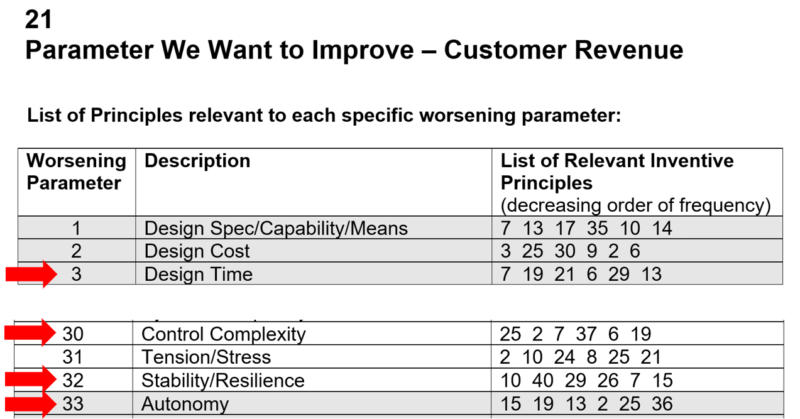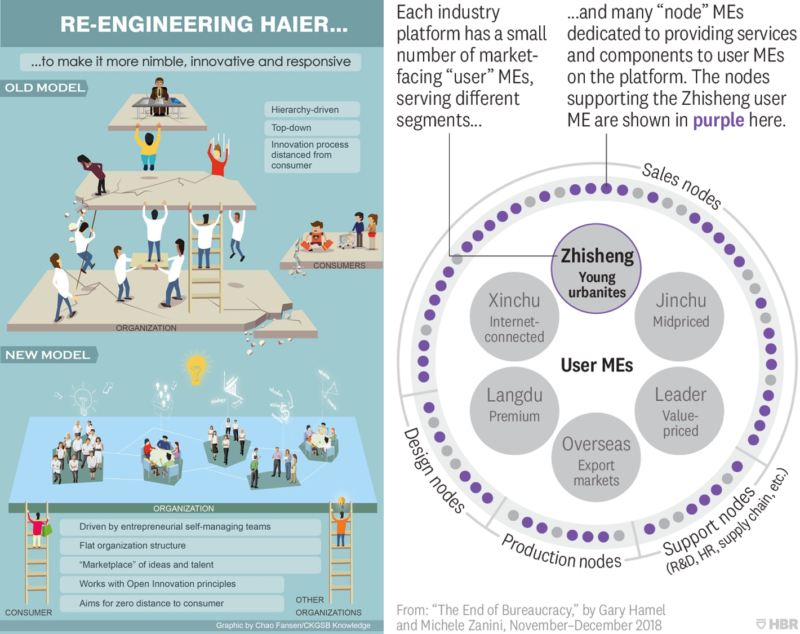I’ve just finished reading Gary Hamel’s new book, Humanocracy, the best chapter of which offers up an in-depth analysis of white-goods manufacturer, Haier’s, business model. The book is about the need to eliminate bureaucracy from organisatons, and Haier is used as an exemplar of what’s possible. Even if, like Haier, you have 84,000 employees to look after.
The overall bureaucracy story makes for a classic business contradiction: the bigger an organisation becomes, the more layers of management it requires in order to make sure everyone is doing what they’re supposed to be doing in order to, in turn, maximise the efficiency of the business. Or at least that’s been the traditional thinking since the advent of large organisations, and particularly the arrival of Frederick Winslow Taylor’s ‘Scientific Management’.
There are various ways of looking at the contradiction. At the physical contradiction level, we want bureaucracy and we don’t want bureaucracy: we want it because it enables stability and, assuming we do it right, operational efficiency; we don’t want it because, as the organisation gets bigger, controlling it becomes progressively more complex, it stifles employee autonomy and therefore innovation, and it impairs agility because the multiple layers of hierarchy each add friction that impedes communication.
We could also shift the problem to a higher level by focusing on the primary job of the organisation, which in Haier’s case is to generate sustainable revenue/profit from customers. What then prevents this is control complexity, the simultaneous need for stability and rapid creation of new offerings, and the lack of employee decision-making autonomy. When we have a multi-faceted set of contradictions like this, often the best way to map it is to revert to the tabular form of the Contradiction Matrix. Something like this:

By forcing ourselves to look at several conflict pairs like this, we obtain a long list of Inventive Principle suggestions. The majority of which, in this case, we can see have been implemented at Haier:
Principle 2, Taking Out – in the drive to eliminate the gap between customer and employee, over the course of the last 10 years the company has eliminated 10,000 middle management positions; then the business has been separated into more than four-thousand ‘micro-enterprises’ (MEs).
Principle 13, The Other Way Around – top-down command-and-control management structures have been replaced with bottom-up autonomy; every employee becomes an entrepreneur rather than an employee.
Principle 25, Self-Service – each of the MEs operates largely autonomously; when potential new customer opportunities are identified, they are free to build new offerings to meet those needs.
Principle 6, Universality – each of the MEs, in keeping with the universal size of human empathy group, has between 10-15 people within it.
Principles 15, Dynamics/29, Fluid – as the overall business grows its web-centric ecosystem, more MEs are formed; as business needs shift, MEs are able to decide how best to morph to suit emerging needs.
Principle 7, Nested Doll – each of the MEs is situated within a higher level ‘platform’ (see figure below).
Principle 40, Composite – each ME incorporates all of the requisite skills required to deliver their intended outcomes; thanks to the entrepreneurial spirit, individuals recognise the need to be multi-skilled rather than specialised in just one area.

On every meaningful metric, Haier is now out-performing its competitors. This won’t be too much of a surprise to TRIZ aficionados: when a business is designed along ‘self-x’-based Ideal Final Result lines (Haier calls it ‘rendanheyi’), traditional to-down, command-and-control enterprises stand no chance.
Anything I say here about the enormity of Haier’s achievement will inevitably sound glib. Anyone interested in digging deeper, should check out Humanocracy. Anyone interested in digging deeper still, should go and talk to people in any of the company’s MEs.
For me, meanwhile, I’m just happy that the world now has a second addition to the Innovation Capability Maturity Level Five club. I suspect, this being the case, the Haier journey is still just beginning.
